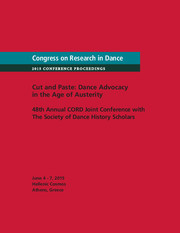No CrossRef data available.
Article contents
The Cuna: An Expression of Cultural Preservation and Creole Identity in Nineteenth Century New Mexico
Published online by Cambridge University Press: 02 August 2016
Abstract
Spanish dance history begins in Roman times with the puellae Gaditanae, the temple dancers who expressed eastern Mediterranean fertility rites through a legendary sensuality. Nineteenth-century accounts of dance in New Mexico that allude to highly sensual movements suggest a continuation of this representation of the female dancing body. In an 1846 diary detailing her travels on the Santa Fe Trail, Susan Magoffin offers a report of the cuna as witnessed in a gambling hall in Santa Fe. Her descriptions echo accounts of notorious Spanish dances from previous centuries like the zarabanda and the zorongo—dances created at crossroads in the Spanish Americas where Spaniards, black Africans, Native peoples, and other Europeans intersected. Studies show that the Spanish language spoken by old New Mexican families contains many archaic elements that have been lost in other Spanish-speaking countries due to the State's isolated geographic location. Like Spanish terminology, were the cuna and other dances remnants of dances forgotten in other Spanish lands? In the first half of the nineteenth century, New Mexico progressed from a Spanish colony to the northern frontier of independent Mexico, before it was absorbed into the United States. Building on narratives found in eyewitness accounts, this paper will explore the role of dance as a preservation site of old Spanish practices as it was shaping a unique New Mexican creole identity.
- Type
- Research Article
- Information
- Copyright
- Copyright © Kathy M. Milazzo 2016


